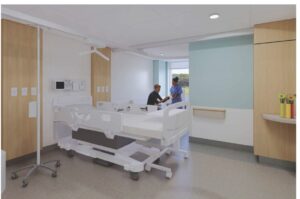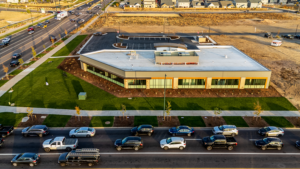In 2025, we can expect a healthcare landscape driven by innovation, consolidation and value creation. The post Four Key Expert Healthcare Construction Predictions for 2025 and Beyond appeared first on HCO News.
By Supina Mapon
In 2025, we can expect a healthcare landscape driven by innovation, consolidation and value creation. After a few rocky financial years, this year marks a potential turnaround period, driven by groundbreaking advancements in artificial intelligence to new models of care delivery. Though health systems are still grappling with rising costs, workforce shortages, and demand driven by aging populations, the pace of innovation and its adoption offer opportunity to address these challenges in a real and sustained way. As we look ahead to the rest of the year, we anticipate the following trends to influence healthcare facility planning and operations.
The Continued Integration of Technology: Building “Phygital” Spaces
The convergence of physical and digital healthcare is transforming the design of medical facilities and must be considered at the start of any new project. The rise of telehealth, AI-driven diagnostics, and digital health tools are prompting healthcare organizations to create hybrid spaces that accommodate both in-person and virtual care—a concept known as “phygital” health.
Nearly 90% of health systems executives surveyed in a McKinsey & Company survey reported that digital and AI transformation is a high or top priority for their organization. We can expect to see increased capital allocation towards digital care and IT focused on enabling frictionless, personalized care experiences no matter where the care encounter takes place. This will include investments in artificial intelligence, machine learning, remote patient monitoring, smart beds, biosensors and more.
This means facility planners should embrace flexibility and create spaces that can effortlessly transition between physical and digital care to improve patient outcomes and boost efficiency.
Evolution in Building Technology: Navigating Rising Costs via Strategic Solutions
The aging demographic, inflation and rising labor costs will continue to challenge efforts to contain health care costs. These growing financial pressures make it crucial that healthcare organizations reconsider their facility designs and operations at all levels.
Additionally, rising material, energy and labor costs will necessitate innovative budget management approaches without compromising quality. Modular construction and prefabrication are effective solutions, as they reduce construction times and minimize waste. These methods lower costs and enable facilities to adapt swiftly to changing demands, such as the increase in outpatient care.
Healthcare leaders should also consider energy-efficient designs and sustainable practices to reduce long-term operating expenses. Integrating solar panels, energy recovery systems, and innovative building technologies is becoming standard in new healthcare projects. By optimizing construction and operational costs while prioritizing patient care, healthcare facilities can better navigate anticipated financial pressures.
Shifting Care Models: From Inpatient to Outpatient
Over the past 25 years, inpatient admissions per 1,000 have dropped from 120 to 95, while outpatient care has spiked from 1,800 per 1,000 to 2,400. This growth has necessitated increased investments in outpatient facilities, including medical office buildings, ambulatory surgical care centers, urgent care clinics and specialty hubs.
As outpatient revenue rises with this significant increase in visits, healthcare providers must adapt their facilities to become more customer centric. To do so, they must create technologically advanced, efficient and easily accessible environments. This trend presents a unique opportunity for the healthcare construction industry to innovate and develop facilities that enhance the patient’s experience while optimizing operational efficiency. The focus will be on building adaptable, patient-centric spaces that cater to the rising demand for convenient, high-quality outpatient care, effectively managing the projected volume increase.
Workforce and Collaboration: Addressing Labor Shortages and Building Smarter Spaces
Workforce labor challenges are prompting a transformation in facility design, emphasizing productivity improvements and the support of collaborative workflows.
Automation and AI-powered tools are proving essential in filling workforce gaps. Technologies such as automated patient monitoring systems and AI-driven scheduling tools help reduce administrative burdens, allowing clinical staff to prioritize patient care. Facility layouts are also changing, featuring centralized nursing stations, streamlined workflows, and ergonomic designs that minimize staff fatigue and enhance efficiency.
Moreover, successful project execution now requires close interdisciplinary collaboration. Healthcare construction involves coordinated efforts among architects, engineers, clinicians, and sustainability experts. Adopting prefabrication and modular construction methods enables teams to work more effectively, delivering projects more quickly while adhering to high quality and sustainability standards.
By embracing collaborative approaches and technology-driven solutions, healthcare facilities can tackle workforce challenges and create environments that benefit both patients and staff.
Looking Ahead
The future of the healthcare industry will be shaped by its ability to adapt to economic pressures, technological advancements, and changing care models – and that future starts now. Healthcare facilities must evolve to address these challenges while balancing financial constraints with the need for innovation and patient-centered design. As leaders in the healthcare sector embrace these trends, the coming years promise to bring more efficient, adaptable, and impactful healthcare infrastructure.
Supina Mapon is a healthcare strategist for DPR Construction, a national self-performing general contractor specializing in technically complex and sustainable projects.
The post Four Key Expert Healthcare Construction Predictions for 2025 and Beyond appeared first on HCO News.













